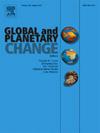Undervalued CO2 emissions from soil to the atmosphere in seismic areas: A case study in Tangshan, North China
IF 4
1区 地球科学
Q1 GEOGRAPHY, PHYSICAL
引用次数: 0
Abstract
A large quantity of CO2 produced in the Earth's interior is emitted to the atmosphere via soil diffusion, especially in active tectonic areas. Due to the lack of extensive in situ measurements, however, estimations of soil CO2 output have been poorly constrained thus far, leading to the perception that soil CO2 seems to be a marginal source of global carbon emissions. Here, the contribution of soil CO2 to the atmosphere is discussed based on soil degassing rates measured at 187 sites in the Tangshan seismic area, North China. The measured degassing rates ranged from 9.04 g m−2d−1 to 230.42 g·m−2d−1, with an average of 87.46 g·m−2d−1, suggesting that high degassing rates are common throughout the region. Carbon isotopic results show that the soil CO2 comes mainly from the deep-seated carbonates and shallow biogenetic processes. Using the threshold value of the data population (96.20 g·m−2d−1), the background and anomalous areas are distinguished. We find that anomalous degassing areas overlap well with epicenters of earthquakes with magnitudes greater than 5. The total annual CO2 output in anomalous areas was estimated to be 38 Mt. This extremely high value can be attributed to the enlarged degassing areas and enhanced CO2 emissions induced by regional active faults and frequent seismic activities. Our results indicate that the impact of soil CO2 emissions in seismic regions should receive increased attention.
被低估的地震区土壤向大气的二氧化碳排放量:华北唐山案例研究
地球内部产生的大量二氧化碳通过土壤扩散排放到大气中,特别是在活跃的构造区。然而,由于缺乏广泛的原位测量,迄今为止对土壤二氧化碳输出的估计受到了很差的限制,导致人们认为土壤二氧化碳似乎是全球碳排放的一个边缘来源。本文基于唐山震区187个测点的土壤脱气率,讨论了土壤CO2对大气的贡献。测定的脱气速率范围为9.04 ~ 230.42 g·m−2d−1,平均为87.46 g·m−2d−1,表明该区普遍存在较高的脱气速率。碳同位素结果表明,土壤CO2主要来自深层碳酸盐岩和浅层生物成因作用。利用数据总体阈值(96.20 g·m−2d−1)区分背景区和异常区。我们发现异常脱气区与5级以上地震的震中有很好的重叠。异常区的年二氧化碳总产量估计为38mt,这一极高的值可归因于区域活动断层和频繁地震活动导致的脱气面积扩大和二氧化碳排放量增加。我们的研究结果表明,震区土壤CO2排放的影响应得到更多的关注。
本文章由计算机程序翻译,如有差异,请以英文原文为准。
求助全文
约1分钟内获得全文
求助全文
来源期刊

Global and Planetary Change
地学天文-地球科学综合
CiteScore
7.40
自引率
10.30%
发文量
226
审稿时长
63 days
期刊介绍:
The objective of the journal Global and Planetary Change is to provide a multi-disciplinary overview of the processes taking place in the Earth System and involved in planetary change over time. The journal focuses on records of the past and current state of the earth system, and future scenarios , and their link to global environmental change. Regional or process-oriented studies are welcome if they discuss global implications. Topics include, but are not limited to, changes in the dynamics and composition of the atmosphere, oceans and cryosphere, as well as climate change, sea level variation, observations/modelling of Earth processes from deep to (near-)surface and their coupling, global ecology, biogeography and the resilience/thresholds in ecosystems.
Key criteria for the consideration of manuscripts are (a) the relevance for the global scientific community and/or (b) the wider implications for global scale problems, preferably combined with (c) having a significance beyond a single discipline. A clear focus on key processes associated with planetary scale change is strongly encouraged.
Manuscripts can be submitted as either research contributions or as a review article. Every effort should be made towards the presentation of research outcomes in an understandable way for a broad readership.
 求助内容:
求助内容: 应助结果提醒方式:
应助结果提醒方式:


